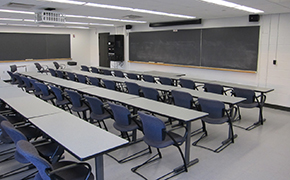Instructor Insights pages are part of the OCW Educator initiative, which seeks to enhance the value of OCW for educators.
Course Overview
This page focuses on the course 16.90 Computational Methods in Aerospace Engineering as it was taught by Professors Karen Willcox and Qiqi Wang in Spring 2014.
This course provided an introduction to numerical methods and computational techniques arising in aerospace engineering. Applications were drawn from aerospace structures, aerodynamics, dynamics and control, and aerospace systems. Techniques covered included numerical integration of systems of ordinary differential equations; numerical discretization of partial differential equations; and probabilistic methods for quantifying the impact of variability. Specific emphasis was given to finite volume methods in fluid mechanics, and finite element methods in structural mechanics.
This course was taught using the Residential MITx platform.
Course Outcomes
Course Goals for Students
- Attain a conceptual understanding of computational methods commonly used for analysis and design of aerospace systems
- Achieve a working knowledge of computational methods, including experience implementing them in model problems drawn from aerospace engineering applications
- Possess a basic foundation in theoretical techniques to analyze the behavior of computational methods
Because students came to class having already engaged with the course materials, we were able to use in-class time for recitation-style interactions. Instead of lecturing for the full session, we focused on talking through the difficult parts of the theory and methods they had read about before class. Flipping the classroom also created opportunities for problem-solving in class.
— Karen Willcox
Below, Professor Karen Willcox describes various aspects of how she taught 16.90 Computational Methods in Aerospace Engineering.
Curriculum Information
Prerequisites
- 16.004 Unified Engineering or permission of the instructor
- Concurrent enrollment in 16.09 Statistics and Probability or 6.041 Probabilistic Systems Analysis
Requirements Satisfied
16.90 can be applied towards a Bachelor of Science in Aerospace Engineering, but is not required.
Offered
Every spring semester
Assessment
Grade Breakdown
The students' grades were based on the following activities:
 12% Reading questions and problem sets
12% Reading questions and problem sets 36% Projects
36% Projects 25% Midterm exam
25% Midterm exam 25% Final exam
25% Final exam 2% Class participation
2% Class participationInstructor Insights on Assessment
Professor Karen Willcox shares her insights about assessing students through oral exams.
Student Information

Breakdown by Year
Mostly juniors and seniors
Breakdown by Major
Mostly aeronautics and astronautics majors
During an average week, students were expected to spend 12 hours on the course, roughly divided as follows:
In Class
- Course met 2 times a week for 1.5 hours per session; 25 sessions total.
- WebEx broadcasting of class sessions allowed students time away from campus to participate in engineering competitions or presenting at conferences.
- Sessions included concept questions, small group exercises, and project work.
Out of Class
- Online readings that included multiple choice, true/false, and short answer questions
- Problem sets
- Three programming projects
- Preparation for oral mid-term and final exams
Semester Breakdown
| WEEK | M | T | W | Th | F |
|---|---|---|---|---|---|
| 1 |  |  |  |  |  |
| 2 |  |  |  |  |  |
| 3 |  |  |  |  |  |
| 4 |  |  |  |  |  |
| 5 |  |  |  |  |  |
| 6 |  |  |  |  |  |
| 7 |  |  |  |  |  |
| 8 |  |  |  |  |  |
| 9 |  |  |  |  |  |
| 10 |  |  |  |  |  |
| 11 |  |  |  |  |  |
| 12 |  |  |  |  |  |
| 13 |  |  |  |  |  |
| 14 |  |  |  |  |  |
| 15 |  |  |  |  |  |
| 16 |  |  |  |  |  |
 No classes throughout MIT
No classes throughout MIT Class session
Class session Reading/homework due
Reading/homework due No class session scheduled
No class session scheduled Oral exam
Oral exam

 Room 1 of 1
Room 1 of 1 